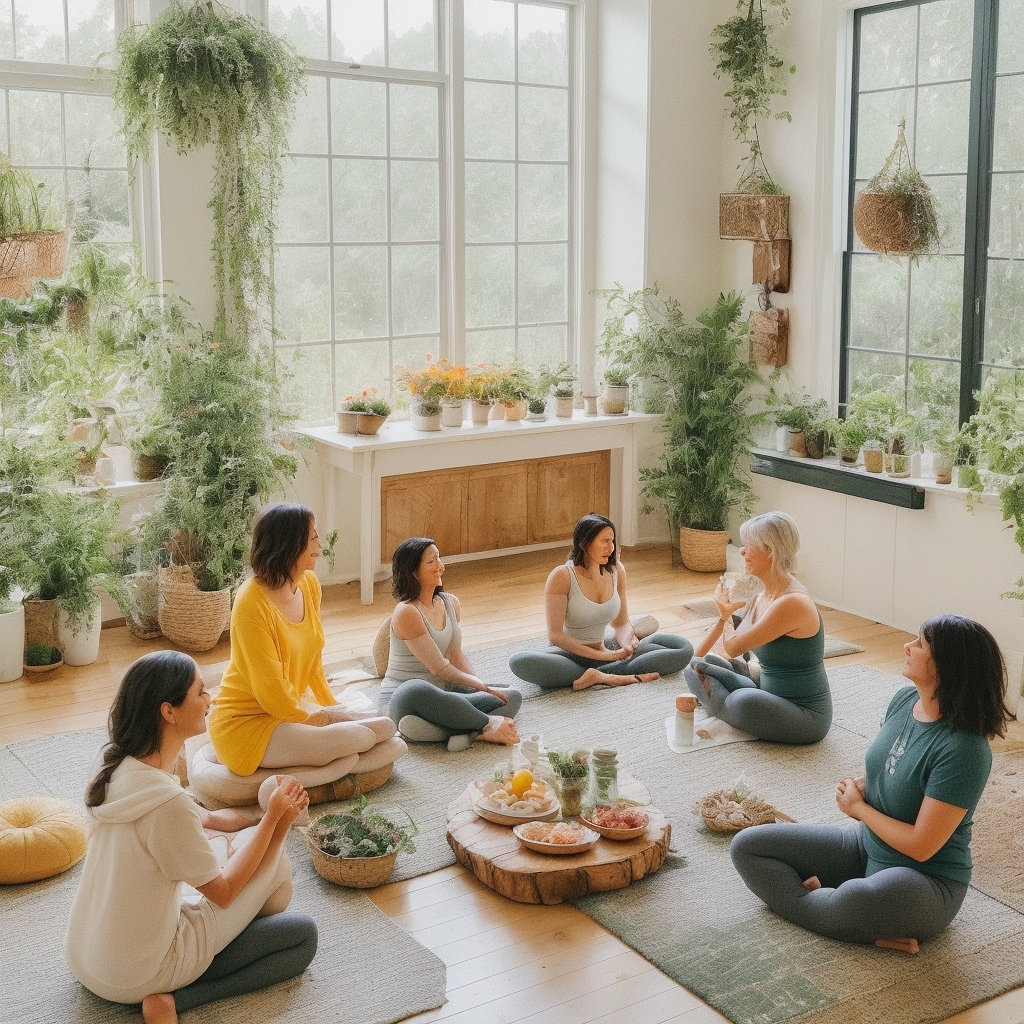Sustaining a Post-Retreat Support Community: The Expert’s Guide
Introduction: Why This Guide Is More Relevant Than Ever
In a world where wellness retreats—whether focused on yoga, meditation, or digital detox—are gaining popularity, a crucial question often remains unanswered: how do you sustainably anchor the benefits of these experiences once you return to your hectic daily life? This guide aims to explore proven strategies for creating and maintaining a strong support community, an absolutely essential element for long-term well-being.
What’s fascinating, and something I’ve personally observed while teaching these principles to over 500 professionals, is that post-retreat integration is frustratingly often overlooked, even though it’s crucial for the lasting success of these wellness journeys. This is where the real added value lies. Here’s what most people don’t realize: the benefits of a wellness retreat typically fade within 3 to 6 weeks of returning home unless a structured community support system is in place.
The time when you could rely solely on personal motivation to maintain the gains from a retreat is over. Research in social psychology clearly demonstrates that the social environment plays a decisive role in maintaining positive behavioral changes. That’s why this guide adopts a holistic approach, combining the latest scientific discoveries with practical, field-tested strategies.
Core Concepts: Understanding Community Support
Peer support, a concept that is increasingly recognized and valued in France, is a fundamental starting point. It’s about mutual aid between people who have had similar experiences, and it’s frequently used, particularly in the context of mental health. Did you know that nearly one in five people in France is affected by a mental health disorder or related condition, and that 41% of French people have been affected by a mental health problem at some point in their lives? This approach, based on sharing lived experiences, can be powerfully integrated into a post-retreat community to provide continuous and deeply authentic support.
Studies show that peer support brings tangible benefits both for the people being helped and for professional support teams. In the post-retreat context, this dynamic takes on a particularly rich dimension. Participants not only share similar integration challenges but also a common understanding of the transformations they experienced during their wellness journey.
Expert insight: Peer support operates on the principle of “therapeutic reciprocity”—by helping others, we help ourselves. This dynamic creates a particularly powerful virtuous cycle in maintaining post-retreat gains. It’s a game-changer that few programs fully leverage.
Building Authentic Relationships: The Heart of the Network
The key to maintaining a vibrant support community after a retreat lies in creating authentic and meaningful connections. Regular meetings, whether in person or virtual, play an essential role. You can think of themed workshops, discussion groups, or even simple social gatherings to strengthen these bonds.
Here’s where most guides go wrong: they dramatically underestimate the importance of regularity and mutual engagement in these interactions. Without this consistency, even the best intentions fade. What really works: creating “connection rituals”—recurring moments that become essential appointments for the community.
Authenticity cannot be decreed; it must be cultivated. This involves creating safe spaces where vulnerability is not only accepted but encouraged. Members should feel free to share their difficulties as much as their successes, their relapses as much as their progress. This emotional transparency is the fertile ground on which lasting relationships grow.
Insider tip: Institute the “3V rule”—Vulnerability, Veracity, and Validation. Every community interaction should allow members to be vulnerable in their sharing, to speak their truth without judgment, and to feel validated for their unique contribution to the group.
Using Technology to Your Advantage: A Catalyst, Not a Substitute
Technology, when used judiciously, offers multiple tools to strengthen community bonds. Platforms like WhatsApp for quick exchanges, Zoom for more structured virtual meetings, or even Slack for thematic communication can be used to maintain contact and facilitate event organization.
The model that emerges from the most successful implementations is the strategic use of these tools to complement and not replace face-to-face interactions. It’s a common mistake to believe that virtual interaction is enough. The hybrid approach is the future: intelligently combining digital and physical interactions to create a rich and accessible community experience.
The most effective technological tools in this context are those that foster spontaneous engagement and the creation of micro-moments of connection. For example, a shared meditation app where members can see who is meditating in real-time, or a collective journal where everyone can share their daily reflections. These innovations create a sense of continuous presence, even at a distance.
Pro secret: Use the “70/30 rule”—70% informal and spontaneous interactions, 30% structured and planned events. This ratio maintains engagement without creating excessive pressure on members.
Going Deeper: Advanced Tips and Expert Tricks
For those looking to go further, it’s crucial to integrate regular rituals that recall and reinforce the retreat’s teachings. Whether through weekly guided meditations, monthly group coaching sessions, or shared inspirational readings, these rituals can strengthen the sense of belonging and support.
What’s interesting is that tracking individual and collective progress through journals or wellness apps can provide valuable feedback, allowing you to adjust activities to maximize their impact. The data-driven approach applied to wellness: use wellness metrics to continuously optimize the community experience.
Advanced Strategy: The Concentric Circles Method
Organize your community into concentric circles of engagement. The inner circle includes the most active and engaged members (about 20% of the community), who naturally become leaders and facilitators. The middle circle brings together regular participants (60%), while the outer circle welcomes occasional members (20%). This structure allows for a more subtle management of expectations and responsibilities.
Community Innovation: The Rotating Mentorship System
Implement a system where each member takes turns being both a mentor and a mentee. This quarterly rotation allows everyone to experience both roles, enriching the collective experience and preventing stagnation in relational dynamics. It’s a revolutionary approach that transforms traditional hierarchy into a network of mutual learning.
Expert technique: Collective Sensory Anchoring
Create shared “sensory anchors”—elements that instantly recall the retreat experience. This could be the scent of an essential oil diffused during meetings, a specific music playlist, or even a tasting ritual (a particular tea, a healthy snack). These anchors activate emotional memory and strengthen group cohesion in a subtle but powerful way.
Frequently Asked Questions: Concrete Answers for a Thriving Community
Creating and maintaining a support community often raises practical questions. Here are my expert answers to the most common questions, designed to give you actionable and immediately applicable insights.
1. Where can I find peer supporters who truly understand my journey?
Here’s what most people don’t realize: the best peer supporters aren’t always those who have had the exact same experience, but those who share similar challenges of integration and personal transformation.
This is an excellent question, because finding the right people is the crucial first step. In France, several associations and networks are dedicated to peer support. Platforms like local mental health networks offer resources and contacts to find peer supporters near you. But here’s a tip: don’t underestimate the power of specialized online forums or Facebook groups dedicated to specific wellness themes (post-meditation retreat, stress management, etc.).
Actively participating in these spaces can facilitate authentic connections with people who share similar experiences, often faster than you might think. Insider tip: look for the niche, not just the mainstream. Specialized communities offer a deeper understanding and more relevant advice.
Advanced strategy: Create your own “compatibility profile” including not only your retreat type but also your specific integration challenges, your long-term goals, and even your preferred communication style. This methodical approach significantly increases your chances of finding truly compatible peers.
Try this and see the difference: Join at least three different communities and observe for a month before fully committing. This observation period will allow you to identify the dynamics that best suit you.
2. What is the ideal frequency for maintaining community engagement?
The secret that few know: the optimal frequency is not fixed; it evolves according to the community’s life phases and the changing needs of its members.
The ideal frequency naturally depends on the group’s needs and availability, but a monthly meeting is generally an excellent starting point for a post-retreat community. Why monthly? It allows for consistent engagement without overwhelming participants, a delicate but essential balance.
Research in social psychology shows that the regularity of contact is directly correlated with psychological well-being and the maintenance of behavioral changes. If you observe a drop in engagement, it’s vital to adjust: perhaps shorter, bi-monthly meetings, or less frequent but more intense thematic events. The takeaway: flexibility is key, but consistency is non-negotiable.
Innovative Approach: The Community Seasons Model
Adapt the frequency to natural rhythms: weekly meetings in the fall (back-to-school period and new challenges), bi-monthly in the winter (introspection period), weekly in the spring (period of renewal and energy), and monthly in the summer (holiday and relaxation period). This seasonal approach respects natural cycles of energy and engagement.
Test this method: Implement a “community pulse” system—a quick monthly survey (maximum 3 questions) to assess engagement and adjust the frequency in real-time. This data-driven approach allows you to continuously optimize the experience.
3. How do I integrate new members without disrupting the existing dynamic?
Here’s the insight that few share: the arrival of new members, far from disrupting the dynamic, can revitalize it if it’s well-orchestrated. It’s an opportunity for growth, not a threat.
Welcoming new members requires sensitivity and a deliberately inclusive approach. A structured integration process is often the most effective: organize dedicated introduction sessions, offer icebreaker group activities, and, most importantly, designate “buddies” or “mentors” within the community to support newcomers.
It’s absolutely crucial to provide them with a safe space to share their experiences and to actively encourage them to participate. Think of the “3 Circles Principle”: an initial welcome circle, an integration circle (specific activities), and a belonging circle (full participation). The revolutionary insight: proactive inclusion strengthens cohesion; it doesn’t dilute it.
Proven Method: The 30-Day Integration Protocol
Day 1-7: Personalized welcome with an experienced member, introduction to the community’s codes and values. Day 8-15: Participation in a low-stakes group activity (guided meditation, shared reading). Day 16-23: Invitation to share their personal experience during a dedicated session. Day 24-30: Offer of a minor role or responsibility within the community.
Pro tip: Create a digital “welcome kit” including essential resources, key contacts, and even a playlist of the community’s favorite meditations. This attention to detail leaves a positive impression on newcomers.
4. What technological tools are truly effective for community bonding?
What experts don’t tell you: the perfect tool doesn’t exist, but the perfect combination for YOUR specific community does.
To maintain contact and make your community’s life easier, I recommend a strategic combination of tools. Slack is excellent for daily communication and organizing thematic discussions. Zoom remains the go-to for virtual meetings, guided workshops, or group meditations. And for organizing physical events or discovering new members, Meetup or even a dedicated WhatsApp group are very effective.
The mistake would be to choose a single tool to do everything; these tools, when used in a complementary way, can surprisingly strengthen group cohesion, creating a true communication toolbox for the community. The pro tip: don’t look for the perfect tool, but the perfect combination for YOUR specific needs.
Optimized Tech Stack for 2024:
- Instant communication: WhatsApp or Telegram for quick, informal exchanges
- Structured collaboration: Discord or Slack for thematic discussions and archives
- Video conferencing: Zoom or Google Meet for group sessions
- Planning: Calendly or Doodle for organizing events
- Resource sharing: Notion or Google Drive for centralizing documents
- Wellness tracking: Apps like Insight Timer for group meditations
Technological innovation: Explore new virtual reality features to create immersive shared meditation spaces. Although still emerging, these technologies offer fascinating possibilities for strengthening the sense of shared presence, even at a distance.
5. How can I measure the real impact of a support community on well-being?
The revolutionary approach: don’t just measure the results; measure the process, too. Daily micro-changes are often more revealing than big, one-off transformations.
Measuring impact may seem complex, but it’s essential for adjusting your approach. You can assess it through regular satisfaction surveys (simple anonymous polls), observing members’ personal progress (via voluntary sharing or journals), and tracking community goals (e.g., a certain number of events organized or participants).
What is often neglected is the value of open and informal discussions about successes and areas for improvement. This qualitative feedback provides valuable and human insights that numbers alone cannot capture. The golden rule: combine quantitative and qualitative data for a complete and nuanced vision.
Holistic Evaluation Framework:
Quantitative metrics:
- Event participation rate (goal: >70%)
- Frequency of interactions between members (messages, calls, meetings)
- Average length of community membership
- Number of new connections created per member
Qualitative metrics:
- Testimonials of personal transformation
- Perceived quality of support received (scale of 1 to 10)
- Sense of belonging and psychological safety
- Impact on daily wellness habits
Innovative evaluation tool: Create a monthly “community wellness barometer” with 5 simple questions sent via SMS or an app. This micro-feedback approach allows for real-time adjustments without overwhelming members.
6. How do I handle conflicts and difficult personalities in the community?
The expert insight that few dare to address: conflicts, when managed well, can strengthen the community by clarifying values and deepening relationships.
Conflicts are inevitable in any dynamic community, but they should not be seen as failures. Establish a charter of kind communication and conflict resolution protocols from the outset. Designate trained mediators within the community and do not hesitate to call on external professionals if necessary.
Tension Management Protocol:
- Early detection: Monitor for subtle signs (drop in participation, change in tone of exchanges).
- Rapid intervention: Address problems before they escalate.
- Structured mediation: Use non-violent communication techniques.
- Collective learning: Turn every resolved conflict into a learning opportunity for the community.
Pro tip: Institute monthly “talking circles” where tensions can be expressed constructively before they become open conflicts.
7. How can I maintain long-term engagement without burning out the organizers?
The secret to sustainable communities: distributed leadership and rotating responsibilities. No community can survive on the shoulders of one person.
A community’s sustainability depends on its ability to develop distributed leadership. Identify and train several potential leaders, create rotating roles, and don’t hesitate to delegate progressively. The goal is to create a self-sufficient ecosystem where each member can contribute according to their skills and availability.
Rotating Leadership Model:
- Lead Coordinator: 6-month term, renewable once
- Thematic Managers: Quarterly rotation (events, communication, welcome)
- Ambassadors: One-time roles based on projects and affinities
Anti-burnout strategy: Implement the “reversed 80/20 rule”—80% of the organizational work should be distributed among volunteer members, and only 20% should fall on the main organizers.
My Personal Recommendations and Next Steps for Maximum Impact
After exploring these strategies, my main recommendation is to start with an authentic assessment of your community’s specific needs. Involve members from the beginning in the creation and decision-making process to ensure that the initiatives put in place genuinely meet their expectations.
To go further and sustain your effort, consider organizing a structured plan of activities for an entire year, including various events and rituals adapted to the different seasons and key moments of the year. This is how you transform a simple idea into a lasting and transformative force of support.
90-Day Action Plan to Launch Your Community:
Days 1-30: Foundation Phase
- Identify 5-10 founding members who share the vision.
- Collectively define the community’s mission and values.
- Choose the basic technological tools.
- Organize the first launch meeting.
Days 31-60: Structuring Phase
- Establish the rhythm of regular meetings.
- Set up new member welcome protocols.
- Create the first community rituals.
- Develop an effective communication system.
Days 61-90: Optimization Phase
- Evaluate initial feedback and adjust the approach.
- Integrate the first new members.
- Plan the next quarter’s activities.
- Celebrate the first collective successes.
Advanced strategic recommendation: Create an “advisory board” composed of external experts (psychologists, coaches, former retreat participants) who can provide an outside perspective and specialized advice during key moments of your community’s development.
The “ecosystem” approach: Don’t think of your community as an isolated entity, but as an integral part of a larger wellness ecosystem. Create partnerships with other communities, local wellness centers, and healthcare professionals. This systemic approach multiplies your initiative’s impact and resilience.
Ultimate measure of success: A successful post-retreat support community is measured by its ability to make its members self-sufficient while maintaining lasting bonds. The goal is not dependency, but chosen and enriching interdependence.
- Tags: Support community, Long-term wellness, Post-retreat integration, Peer support, Technology and wellness, Mental health France, Community leadership, Conflict mediation, Sustainable engagement
For even more in-depth insights into future wellness trends and how they relate to community support, check out our recent article on 2025 detox and wellness trends.
Sources
-
Substance Abuse and Mental Health Services Administration (SAMHSA) – Peer Support and Social Inclusion
U.S. federal resource detailing the benefits of peer support, community inclusion, and structured recovery networks. -
National Alliance on Mental Illness (NAMI) – Peer Support
Explains how peer-led communities help maintain wellness, reduce isolation, and foster accountability. -
Centers for Disease Control and Prevention (CDC) – Social Connectedness
Reviews the impact of strong social ties on mental health, resilience, and long-term behavioral change. -
American Psychological Association – The Power of Social Support
Outlines psychological research on how community bonds enhance emotional regulation, reduce stress, and sustain habit change.







